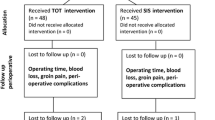Abstract
Introduction and hypothesis
The aim of this study was to test the safety and efficacy of the Solyx single-incision sling (SIS) in women with stress urinary incontinence (SUI).
Methods
A retrospective study of 63 women who had undergone implantation at three medical centers (December–March 2009) was conducted.
Results
Mean patient age was 51 years (range, 30–87 years); 37 (59%) patients had concomitant urogynecological procedures. At a mean follow-up of 6.5 months (range, 5–8 months), 95% of patients were dry on the basis of subjective and objective assessment. Two patients experienced transient urinary retention, which resolved spontaneously. No complications of the procedure were reported, including no bladder, bowel, vessel, or nerve perforations and no erosions or extrusions. No pain was reported that was attributed to the implant.
Conclusions
The very early efficacy results indicate that the Solyx SIS system is an attractive treatment option for SUI. The minimal number of steps involved in the procedure will facilitate uptake of the technique.



Similar content being viewed by others
References
Ulmsten U, Johnson P, Rezapour M (1999) A three-year follow up of tension-free vaginal tape for surgical treatment of female stress urinary incontinence. Br J Obstet Gynaecol 106:345–350
Boustead GB (2002) The tension-free vaginal tape for treating female stress urinary incontinence. BJU Int 89(7):687–693
Kuuva N, Nilsson CG (2002) A nationwide analysis of complications associated with the tension-free vaginal tape (TVT) procedure. Acta Obstet Gynecol Scand 81(1):72–77
Latthe PM, Singh P, Foon R, Toozs-Hobson P (2009) Two routes of transobturator tape procedures in stress urinary incontinence: a meta-analysis with direct and indirect comparison of randomized trials. BJU Int (in press)
Petros PE, Richardson PA (2005) Midurethral tissue fixation system sling—a ‘micromethod’ for cure of stress incontinence—preliminary report. Aust NZ J Obstet Gynaecol 45(5):372–375
Bacarat F, Iglesias R, Pessoa R, Figueiredo JA, Srougi M, Bruschini H (2008) Unfavorable immediate outcome of the TVT Secur sling in twenty consecutive women with stress urinary incontinence. J Urol 179(4):535–536
Araco F, Gravante G, Sorge R, Overton J, De Vita D, Sesti F, Piccione E (2008) TVT-O vs TVT: a randomized trial in patients with different degrees of urinary stress incontinence. Int Urogynecol J Pelvic Floor Dysfunct 19(7):917–926
Neuman M (2007) TVT and TVT-obturator. Comparison of two operative procedures. Eur J Obstet Gynecol Reprod Biol 131(1):89–92
Liapis A, Bakas P, Giner M, Creatsas G (2006) Tension-free vaginal tape versus tension-free vaginal tape obturator in women with stress urinary incontinence. Gynecol Obstet Invest 62(3):160–164
Debodinance P (2006) Trans-obturator urethral sling for surgical correction of female stress urinary incontinence: outside-in (Monarc) versus inside-out (TVT-O). Are both ways safe? J Gynecol Obstet Biol Reprod (Paris) 35(6):571–577
Roth TM (2007) Management of persistent groin pain after transobturator slings. Int Urogynecol J Pelvic Floor Dysfunct 18(11):1371–1373
Waltregny D, Reul O, Mathantu B, Gaspar Y, Bonnet P, de Leval J (2006) Inside out transobturator vaginal tape for the treatment of female stress urinary incontinence: interim results of a prospective study after a 1-year minimum followup. J Urol 175(6):2191–2195
deTayrac R, Deffieux X, Droupy S, Chauveaud-Lambling A, Calvanese-Benamour L, Fernandez H (2004) A prospective randomized trial comparing tension-free vaginal tape and transobturator suburethral tape for surgical treatment of stress urinary incontinence. Am J Obstet Gynecol 190(3):602–608
Smith ARB, Hilton P (2008) 2 year follow-up of prospective cohort study of single incision, short segment, transvaginal tape inserted under local anaesthesia (oral poster 9). Presented at the 33rd Annual International Urogynecological Association Meeting, 13–17 September, Taipei, Taiwan
Petros PE, Richardson PA (2008) Midurethral tissue fixation system (TFS) sling for cure of stress incontinence—3 year results. Int Urogynecol J Pelvic Floor Dysfunct 19(6):869–871
Palma P, Riccetto C, Reges R, Fraga R, MiyaokaR HermannV, Marcondes T (2008) Arcus to arcus microsling: technique and preliminary results. Int Urogynecol J 19(8):1133–1136
Moore RD, Mitchell GK, Miklos JR (2009) Single-center retrospective study of the technique, safety, and 12-month efficacy of the MiniArc single-incision sling: a new minimally invasive procedure for treatment of female SUI. Surg Technol Int 18:175–181
Alinsod R, Safir M, Browning J (2009) Initial outcomes of a stabilized adjustable minisling for female urinary stress incontinence. Abstract 865, ICS Annual Congress, San Francisco, CA, USA
Meschia M, Barbacini P, Ambrogi V, Pifarotti P, Ricci L, Spreafico L (2009) TVT-secur: a minimally invasive procedure for the treatment of primary stress urinary incontinence. One year data from a multi-centre prospective trial. Int Urogynecol J Pelvic Floor Dysfunct 20(3):313–317
Serels S (2009) Cadaveric assessment of synthetic mid-urethral sling placement. Presented at the 30thWorld Congress of the Société Internationale d'Urologie Meeting, 1–5 November, Shanghai, China
Acknowledgement
This paper was supported by a restricted educational grant from Boston Scientific.
Conflicts of interest
The authors received honoraria for lecturing on behalf of Boston Scientific.
Author information
Authors and Affiliations
Corresponding author
Additional information
An erratum to this article can be found at http://dx.doi.org/10.1007/s00192-010-1110-8
Rights and permissions
About this article
Cite this article
Serels, S., Duoso, M. & Short, G. Preliminary findings with the Solyx™ single-incision sling system in female stress urinary incontinence. Int Urogynecol J 21, 557–561 (2010). https://doi.org/10.1007/s00192-009-1065-9
Received:
Accepted:
Published:
Issue Date:
DOI: https://doi.org/10.1007/s00192-009-1065-9




